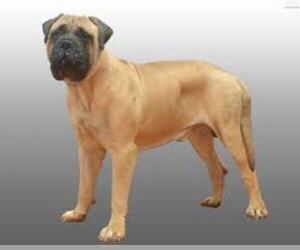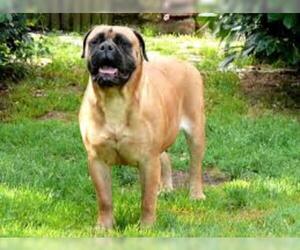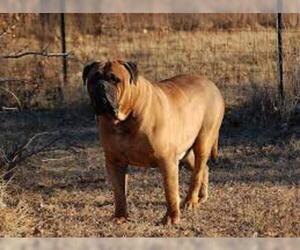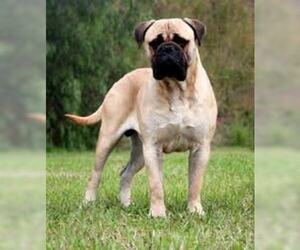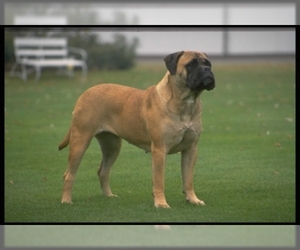
All about Bullmastiff dog breed
A.K.A. :Watchdog of England, Gamekeeper's Night-Dog, Bullie
Size
Grooming requirements
Exercise requirements
Good with other dogs
Watchdog ability
Energetic
Training requirements
Playful
Affectionate
Good with other pets
Good with children
Good with strangers
Winter
Summer
Healthiness
Protective
Life Span
| Pure Breeds | Member |
| Breeds A - Z | B |
| Breeds by Group | Flock Guards & Mastiffs Working |
| Breeds by Trait | Good With Kids Low Shedding |
| Overview: | The Bullmastiff is a dignified and powerful breed, originating in 19th-century England as a gamekeeper's dog, specifically bred to deter poachers without causing serious harm. This large and muscular dog boasts a short, dense coat typically in fawn, red, or brindle, often with a striking black mask. Despite their imposing appearance, Bullmastiffs are known for their gentle, loyal, and affectionate temperament with their families, often referred to as a "gentle giant." They are generally good with children when properly socialized, making them suitable for active families. While their size might suggest otherwise, they can adapt to apartment living if provided with sufficient daily exercise and mental stimulation, as they are not overly high-energy dogs. However, their ideal environment includes a securely fenced yard. Potential owners should be aware of common health concerns such as hip and elbow dysplasia, bloat, and certain cancers. With proper care and training, a Bullmastiff makes a devoted and protective companion. |
F.A.Q.
All You Need to Know About the Bullmastiff Breed
The Bullmastiff is a magnificent, powerful breed originating in 19th-century England, developed by gamekeepers to deter poachers. Known as the "Gamekeeper's Night Dog," they possess a natural protective instinct, making them excellent, loyal family guardians. Despite their imposing size, reaching up to 130 pounds, Bullmastiffs are remarkably gentle and affectionate with their families, thriving on companionship. They have a short, dense coat, requiring minimal grooming—weekly brushing suffices. Exercise needs are moderate; daily walks and playtime are essential, but they aren't built for endurance. While adaptable, their size makes apartment living challenging, favoring homes with secure yards. Prospective owners should be aware of potential health issues like hip and elbow dysplasia, bloat, and certain cancers. With proper training and socialization, a Bullmastiff can be a devoted, loving addition to the right home.Bullmastiff Weight: The average size for a healthy adult Bullmastiff ranges from 100 to 130 pounds. Males typically weigh between 110-130 lbs, while females are usually 100-120 lbs. This provides a good guide for the healthy weight for Bullmastiff.
Wondering, "How tall is a Bullmastiff?" You've come to the right place!
The average height of a Bullmastiff is quite impressive, with these majestic dogs typically standing between 25 to 27 inches tall at the shoulder as fully grown adults. This measurement is taken from the ground to the highest point of their shoulder blade.- Males (Dogs): Generally, male Bullmastiffs are on the taller side of the spectrum, typically ranging from 25 to 27 inches.
- Females (Bitches): Female Bullmastiffs are usually slightly shorter, falling into a range of 24 to 26 inches.
The Bullmastiff breed colors primarily include fawn and brindle, which are the AKC recognized Bullmastiff colors. A dark mask is also a distinguishing feature. Red is also an accepted fawn variation. While these are the standard and most common, you may encounter rare coat types or exotic Bullmastiff variations that are not accepted by major kennel clubs. These can include chocolate Bullmastiffs, blue Bullmastiffs, black Bullmastiffs, or even patterns like merle. It's important to note that these unusual Bullmastiff colors are often the result of crossbreeding or specific genetic mutations and are typically not desired in purebred lines according to breed standards. Potential adopters should be aware that while these rare Bullmastiff colors may exist, they are not recognized by the AKC and may indicate a non-purebred lineage or health concerns.
The Bullmastiff personality is a fascinating blend of power and gentleness. Known for their immense loyalty, they are devoted family guardians with a surprisingly affectionate nature. Despite their formidable appearance, Bullmastiff temperament is generally calm and confident, rarely aggressive without cause. They are friendly towards their own family, often seeking close proximity and enjoying gentle play. With strangers, they are typically reserved but watchful, possessing a natural protective instinct.While not overly energetic, Bullmastiffs do require regular exercise to maintain their health and prevent boredom. They are moderately adaptable to apartment living, provided they receive sufficient outdoor time and mental stimulation; however, a house with a yard is generally preferred. Their loyalty extends to children, with whom they are often very patient and tolerant, making them good family pets when properly socialized and supervised. Early socialization is crucial for them to learn appropriate behavior around other dogs and pets. When raised with other animals from a young age, they can coexist peacefully, though their protective instincts may surface if they perceive a threat to their "pack." They are intelligent and trainable but can have a stubborn streak, requiring consistent and positive reinforcement methods.
The Bullmastiff temperament is generally described as a devoted, good-natured, and courageous companion dog. They are loyal and form strong bonds with their families, often described as "gentle giants."
Friendliness & Sociability: While typically affectionate with their own family, Bullmastiffs can be reserved and watchful with strangers, a natural extension of their guardian instincts. Early socialization is crucial to ensure they are well-adjusted and comfortable in various situations. They are generally not overtly "friendly" with everyone they meet but rather discerning.Loyalty: Exceptional loyalty is a hallmark of the Bullmastiff. They are very protective of their loved ones and will instinctively guard their home and family, making them excellent deterrents.Apartment Living: Due to their size, Bullmastiffs are not ideal for small apartment living unless they receive significant daily exercise and mental stimulation. They thrive in homes with a yard, though they are not hyperactive outdoors. Inside, they are relatively calm and enjoy being near their people.Behavior with Children: When properly socialized and raised with children, Bullmastiffs can be incredibly patient and gentle. However, due to their size, supervision is always recommended, especially with very young children, to prevent accidental bumps. They are often very tolerant and protective of their "little humans."Behavior with Other Pets: Bullmastiffs can coexist peacefully with other pets, especially if introduced and socialized from a young age. However, their natural guarding instincts may lead to dominance issues with same-sex dogs if not managed properly. Supervision during introductions is always wise.Stubbornness & Sensitivity: While intelligent, Bullmastiffs can exhibit a streak of stubbornness, requiring consistent and positive reinforcement training. They are also quite sensitive to their owner's tone and respond best to kind, firm guidance rather than harsh corrections. They thrive on praise and connection. Understanding these Bullmastiff personality traits is key to a harmonious relationship with this magnificent breed.Bullmastiff Care: Your Guide to Daily MaintenanceBullmastiff care is essential for this gentle giant. While generally low-energy dog breed, they require consistent attention.Grooming Needs: The Bullmastiff's short, dense coat is relatively low maintenance. Weekly brushing helps remove loose hair and promotes a healthy shine. Shedding is moderate. Regular nail trimming (every 3-4 weeks) is crucial to prevent discomfort and splayed feet.Exercise Limitations: Despite their size, Bullmastiffs are not high-endurance dogs. Moderate daily exercise, like two short walks (20-30 minutes each), is sufficient to maintain their health without overexertion. Avoid strenuous exercise, especially in warm weather, due to their brachycephalic (short-nosed) anatomy. Rest is vital, so ensure they have a comfortable, quiet place to nap.Dietary Considerations: Feed a high-quality, large-breed dog food appropriate for their life stage. Portion control is paramount for Bullmastiff weight management to prevent obesity, which can exacerbate joint problems. Divide daily food into two meals to reduce the risk of bloat. Consult your vet for specific dietary recommendations.Wrinkle and Ear Cleaning: Their facial wrinkles require daily cleaning with a damp cloth to prevent skin fold dermatitis and infections. Regularly check and clean their ears to prevent wax buildup and ear infections.Climate Sensitivity: Due to their brachycephalic nature, Bullmastiffs are highly sensitive to extreme temperatures. They overheat easily in hot, humid weather and are susceptible to hypothermia in extreme cold. Keep them indoors in climate-controlled environments. How to care for a Bullmastiff in summer: always provide fresh water and shade.Common Health Concerns & Health Tips for Bullmastiff:* Skin Issues: Regular wrinkle cleaning and a balanced diet help prevent skin fold dermatitis and other skin irritations.* Dental Care: Daily tooth brushing or dental chews are essential to prevent plaque and tartar buildup, which can lead to dental disease.* Weight Management: Strict portion control and regular, moderate exercise are key to preventing obesity and its associated health problems like joint issues.* Be aware of genetic predispositions to hip and elbow dysplasia, bloat, and certain cancers. Regular veterinary check-ups are crucial for early detection and management of these conditions.
Bullmastiff Activity Level: How Active Are Bullmastiff?The Bullmastiff activity level can be described as moderate. They are not a hyperactive breed, but they do require regular, controlled exercise to stay healthy and happy. While they are known for their calm demeanor and love of lounging, it's a common misconception that they need very little activity.Typical Energy Levels: Bullmastiffs exhibit a unique balance of short bursts of energy followed by long periods of rest. They enjoy a good romp but are equally content to nap at your feet.Daily Exercise Needs: Aim for at least 30-60 minutes of daily exercise, which can be broken into several shorter sessions. This might include:* Leashed walks: A few moderate-paced walks throughout the day are ideal.* Playtime in a securely fenced yard: They enjoy sniffing around and exploring.* Brief training sessions: Mental stimulation is just as important as physical.Playtime Preferences: Bullmastiffs enjoy interactive play with their family, such as tug-of-war (with appropriate supervision) or chasing a ball for a short duration. They are not typically inclined towards endless games of fetch. They are also prone to "zoomies" – sudden bursts of energy where they run around quickly – but these are usually short-lived.Limitations Due to Brachycephalic Anatomy: Due to their brachycephalic (short-nosed) anatomy, Bullmastiffs are highly susceptible to overheating, especially in warm or humid weather.* Avoid strenuous exercise during hot weather: Early mornings or late evenings are best.* Always provide access to fresh water: Hydration is crucial.* Watch for signs of overheating: Excessive panting, drooling, or lethargy are warning signs.* Limit high-impact activities: Activities like long-distance running or intense agility training are generally not suitable for this breed.Suitability for Families: Bullmastiff exercise needs make them suitable for both low-energy households and moderately active families. They are not the ideal companion for marathon runners or highly active outdoor enthusiasts seeking a constant exercise buddy. However, they thrive with families who can provide consistent, moderate daily activity and appreciate their calm, loving nature for the rest of the day.
Breed Breakdown: What Experts Say About the Bullmastiff
I would rate the "Size" trait of the Bullmastiff breed a 9 out of 10.The Bullmastiff is a genuinely large breed. Males typically stand 25-27 inches tall and weigh 110-130 pounds, while females are 24-26 inches tall and weigh 100-120 pounds. Their body structure is robust, muscular, and substantial, giving them an imposing presence. When compared to the vast majority of other companion dog breeds, the Bullmastiff easily falls into the very large to giant category, significantly outweighing and out-sizing most breeds. Due to their considerable size and need for space to move comfortably, Bullmastiffs are generally not well-suited for apartment living, frequent travel (especially by air), or households with significant space constraints. They thrive in homes with ample room, preferably a fenced yard, where they can stretch out and move without feeling cramped.
I would rate the grooming requirements of a Bullmastiff at a 3 out of 10.Bullmastiffs are a relatively low-maintenance breed when it comes to grooming. Their short, dense coat is a huge contributor to this, requiring only a weekly brushing to remove loose hair and keep it healthy. While they do shed, it's generally a moderate amount and not excessive, becoming more noticeable during seasonal changes. The main considerations that nudge them slightly above an "extremely low-maintenance" 1 are their potential for skin fold care around the muzzle and jowls, which need regular wiping to prevent irritation or infection, and the general need for routine ear cleaning, nail trimming, and bathing, which are standard for all dogs. They aren't particularly prone to extensive skin issues or allergies compared to some other breeds, and their bathing needs are infrequent unless they get particularly dirty. Overall, they are quite easy to care for and do not require frequent, specialized grooming compared to many other companion dogs.
I would rate the Bullmastiff's exercise requirements as a 3.Bullmastiffs are generally known for their relatively low energy levels and preference for a more relaxed lifestyle. While they do need daily walks to maintain a healthy weight and muscle tone, these walks don't need to be long or intense. A couple of moderate 20-30 minute walks per day, perhaps with some supervised playtime in a securely fenced yard, is typically sufficient. Their brachycephalic (short-nosed) anatomy makes them prone to overheating and respiratory difficulties, especially in warm weather or during strenuous activity, so sustained, high-impact exercise like long runs or agility is not suitable and can be dangerous for them. They are not a breed that thrives with extensive, structured exercise routines; instead, they are content with a moderate amount of activity to keep them healthy and mentally stimulated, followed by ample opportunities for rest and napping. Over-exercising a Bullmastiff can lead to joint problems, especially in their growing puppy stage, and put unnecessary strain on their respiratory system. They are more built for short bursts of effort rather than endurance.
I would rate the Bullmastiff's "Watchdog Ability" at a strong 8 out of 10.While not an incessant barker, the Bullmastiff is exceptionally alert and possesses powerful territorial instincts. They are very attuned to their surroundings and will almost always respond to unfamiliar sounds or people approaching their home with a deep, authoritative bark that is undoubtedly a meaningful early warning. Their imposing size and powerful presence alone are often enough to deter most intruders. They are not merely passive companions; their protective nature is inherent, and they are quick to sense and respond to perceived threats to their household. While they might not be the first to bark at a squirrel outside, they are remarkably effective at recognizing and reacting to genuine anomalies that could indicate an intrusion.
I would rate the "Good with Other Dogs" trait of the Bullmastiff breed a 5 out of 10.Bullmastiffs generally fall into a moderate category when it comes to their compatibility with other dogs. While they are not inherently aggressive, they possess a strong protective instinct and can be prone to dominance, particularly with other dogs of the same sex or those they perceive as a threat to their family or territory. Early and consistent socialization is absolutely crucial for a Bullmastiff to be well-adjusted around unfamiliar dogs. Without it, they can be reserved, aloof, or even confrontational, especially if another dog challenges them. They tend to do better in multi-dog households if they are raised with the other dogs from a young age or if new introductions are carefully managed and supervised, often favoring the opposite sex. Their lower energy levels can sometimes make them less tolerant of very high-energy or boisterous dogs who might constantly try to engage them in play. They don't typically "thrive" in large, rambunctious canine company without significant training and management, but rather require careful introductions and ongoing work to coexist peacefully and respectfully. They are more likely to be tolerant than truly playful with other dogs they don't know well.
I would rate the "Energetic" trait of the Bullmastiff a 3 out of 10.The Bullmastiff is a famously laid-back and relatively low-energy breed. They are not known for their high activity levels or endurance. While they enjoy a good walk and a moderate amount of playtime, they are generally content with lounging around the house and do not require extensive physical stimulation to prevent boredom or destructive behavior. Their playfulness tends to be in short bursts rather than sustained periods. They are definitely on the more laid-back side compared to many other companion dogs.Their brachycephalic (short-nosed) anatomy significantly affects their stamina and exercise tolerance. This facial structure makes them prone to overheating and breathing difficulties, especially in warm weather or during strenuous activity. Consequently, they are not suitable for participating in demanding outdoor or athletic activities and should always be monitored for signs of overheating, even during moderate exercise. They prefer a comfortable indoor environment and are generally content with a couple of moderate walks a day and some gentle play.
I'd rate the Bullmastiff's "Training Requirements" at a 7.While intelligent, Bullmastiffs can be quite stubborn and possess an independent streak that makes them less responsive to commands than some other breeds. Their attention span, especially when young or distracted, can be fleeting, requiring consistent effort to keep them engaged. They are very sensitive and respond best to positive reinforcement, but this needs to be delivered with unwavering consistency and a clear, confident leader. They are not a beginner-friendly breed and definitely require experienced handling and structured routines from day one. Their sheer size and strength mean that any lack of training can quickly become problematic, demanding a firm yet gentle hand and an owner dedicated to ongoing socialization and obedience work.
I'd rate the Bullmastiff's "Playful" trait a 4 out of 10.While they enjoy interaction and can have bursts of "zoomies" or playful wrestling, the Bullmastiff is fundamentally a more laid-back and dignified breed. Their activity level is moderate; they are content with a good walk and some quality time with their family rather than constant high-energy games. They will engage with toys and playtime, especially if it involves their beloved people, but they aren't typically the breed to incessantly demand attention through playful antics. Their enthusiasm in daily life is more geared towards companionship and comfort than boisterous fun. Compared to other companion dogs, they are definitely on the calmer side, often preferring a comfortable snooze at your feet over an extended game of fetch.
I would rate the "Affectionate" trait of the Bullmastiff a 9 out of 10.Bullmastiffs are renowned for their profound love and devotion to their families, placing them firmly on the "extremely loving and people-oriented" end of the spectrum. They possess an intense desire for human companionship and are often described as "Velcro dogs" due to their tendency to follow their owners from room to room. Physical closeness is highly valued; they are notorious for wanting to lean against, sit on, or cuddle with their people, despite their large size. Their loyalty is unwavering, forming deep bonds with their family members and often acting as gentle protectors. They are surprisingly sensitive to their owner's emotions, offering quiet comfort when sensing distress. This breed absolutely thrives on affection and closeness, craving interaction and feeling like an integral part of the family, making them far from independent compared to many other companion dogs.
I would rate the "Good with Other Pets" trait of the Bullmastiff breed a 7 out of 10.Bullmastiffs generally possess a calm and tolerant demeanor, which can extend to other pets within the household, especially if raised with them from a young age. Their prey drive, while present, is typically not as high as some other mastiff-type breeds or terriers, making them less likely to intensely pursue small animals like cats. They are known for their protective nature, which can sometimes translate into a watchful eye over their "pack," including other animals. However, this protective instinct can also manifest as resource guarding if not properly managed, particularly concerning food, toys, or even their human family members. Early and consistent socialization is crucial for Bullmastiffs to ensure they learn appropriate interactions and develop a friendly disposition towards other animals. Without this, their natural reservedness could lead to suspicion or an unwillingness to share. While they are naturally inclined to be loyal and generally good-natured, successful coexistence in multi-pet households often requires diligent training, consistent supervision, and a well-established hierarchy to prevent any potential conflicts arising from their protective instincts or resource guarding tendencies. They are adaptable but thrive best when introduced to other pets carefully and given a clear understanding of boundaries.
The Bullmastiff rates an 8 out of 10 for "Good with Children." They are naturally gentle giants, typically calm, patient, and affectionate with children. Their imposing size often belies a remarkably tolerant and protective nature, making them excellent family companions. They are generally good-natured and accept the usual noise and handling associated with children quite well. While their inherent gentleness means they are largely compatible without extensive specific training for child interaction, supervision is always recommended due to their sheer size, especially with very young children, to prevent accidental bumps. Their protective instincts mean they will often act as a watchful guardian over their little human family members.
I'd rate the Bullmastiff's "Good with Strangers" trait a 4 out of 10. While not inherently aggressive, Bullmastiffs are naturally reserved and protective, bred to be silent guardians rather than effusive greeters. They tend to be wary of unfamiliar adults and will often observe from a distance, exhibiting a calm but watchful demeanor. Their strong guarding instincts mean they are likely to bark at or position themselves between their family and a stranger if they perceive any threat, even if it's just a new guest. While extensive socialization from a young age can help them become more tolerant and polite in public or guest-filled environments, they are not naturally outgoing and will rarely be the dog enthusiastically greeting everyone. Their comfort around strangers generally requires consistent, positive exposure and training to ensure they are well-mannered rather than truly sociable.
I would rate the Bullmastiff's "Winter" tolerance at a 3.Bullmastiffs are decidedly not built for cold weather. Their short, single coat offers very little insulation against the cold, and while their large size and muscle mass provide some thermal inertia, it's quickly lost in frigid temperatures. Their moderate body fat might offer a slight advantage over leaner breeds, but it's insufficient to counteract the lack of a proper winter coat. The brachycephalic (short-nosed) anatomy further complicates matters, as it makes it harder for them to warm inhaled air, increasing the risk of respiratory issues and making them more susceptible to the cold. They are at a significant risk of hypothermia if left exposed to cold for even moderate periods. Compared to many other companion dogs, Bullmastiffs absolutely require special care during winter months; short outdoor excursions for potty breaks should be the norm, and they should be outfitted with a warm, waterproof coat for any time spent outside when temperatures drop significantly. Prolonged outdoor activity in cold climates is not advisable for this breed.
I would rate the "Summer" tolerance of the Bullmastiff breed a 2.Bullmastiffs are highly sensitive to heat due to their brachycephalic (short-nosed) anatomy, which significantly impairs their ability to cool themselves effectively through panting. Unlike longer-nosed breeds, they have a reduced surface area in their nasal passages for heat exchange, making them extremely susceptible to overheating. Their large, dense bodies and relatively thick coats further exacerbate this issue. They have a very low ability to regulate their body temperature in warm weather and are at an exceptionally high risk of heatstroke, which can be fatal even with minimal exertion. Outdoor activity during hot weather is strongly discouraged, and even short walks can be dangerous. Bullmastiffs absolutely require strict climate control during summer months, meaning air-conditioned environments are essential. Compared to most other companion dogs, Bullmastiffs require extensive special care in summer, including constant supervision, restricted outdoor access to only the coolest parts of the day, readily available fresh water, and a primary indoor, air-conditioned environment.
I'd rate the Bullmastiff's "Healthiness" trait at a 4 out of 10.While a majestic and generally sweet-natured breed, the Bullmastiff is unfortunately prone to a significant number of serious health issues that detract from its overall health and resilience. Their large size makes them particularly susceptible to joint problems like hip and elbow dysplasia, often leading to chronic pain and mobility issues. As a brachycephalic (short-nosed) breed, they can experience breathing difficulties, especially in warm weather or during exertion, and are at higher risk for heatstroke. Other common concerns include various types of cancer (lymphoma, osteosarcoma), bloat (gastric dilatation-volvulus), and eye conditions such as entropion and ectropion. Their average life expectancy is relatively short, typically 8-10 years, which further reflects their health challenges.Responsible breeding practices and diligent preventive care, including a healthy diet, appropriate exercise, and regular veterinary check-ups, are absolutely crucial to mitigating some of these risks. However, even with the best care, the genetic predispositions remain significant. Compared to many other companion dogs, the Bullmastiff is considered high-maintenance from a health perspective due to the frequency and severity of its breed-specific ailments, rather than generally robust.
I would rate the "Protective" trait of the Bullmastiff breed a 9 out of 10.Bullmastiffs are renowned for their protective nature, a characteristic that was intentionally bred into them. They exhibit strong alertness, often being the first to notice and react to unusual sounds or presences. Their territorial instincts are highly developed; they consider their home and family their domain to defend. This breed is exceptionally loyal to its owners, forming deep bonds and an inherent desire to keep them safe. When it comes to strangers, a Bullmastiff will typically be reserved and observant, often positioning themselves between their family and the newcomer. Their imposing size and deep bark are significant deterrents.While they are loving and gentle companions with their families, a Bullmastiff is unequivocally capable of offering meaningful protection in a household setting. They are not merely "watchdogs" in the sense of just barking; they possess the physical capability and the inherent temperament to deter and, if necessary, subdue an intruder. They were specifically developed as "gamekeeper's night dogs" to track and hold poachers without mauling them, demonstrating their controlled yet formidable protective drive.
I would rate the "Life Span" trait of the Bullmastiff breed a 3 out of 10.Bullmastiffs are considered a short-lived breed compared to other companion dogs. Their average life expectancy is typically in the range of 7 to 9 years, which is significantly lower than the 10-13 year average for many dog breeds. This shorter lifespan is influenced by their large size and genetic predispositions to certain health issues. Common health concerns that can impact their longevity include various cancers (lymphoma, osteosarcoma), bloat (gastric dilatation-volvulus), heart conditions (subaortic stenosis, dilated cardiomyopathy), and hip/elbow dysplasia, which can lead to mobility issues and pain. While responsible breeding practices and excellent veterinary care can certainly help maximize their lifespan and quality of life, these efforts often combat the inherent genetic and physiological challenges that contribute to their relatively short time with us.
Bullmastiff Dogs for adoptionSee all dogs for adoption
Bullmastiff BreedersSee all breeders
Similar Dog Breeds for Bullmastiff
Breed Mixes of Bullmastiff
Quick Breed Selector 0 - not important, 1 - smallest, 10 - largest
Variants & Mistakes :Bullmastif, Bulmastiff, Bulmastif



